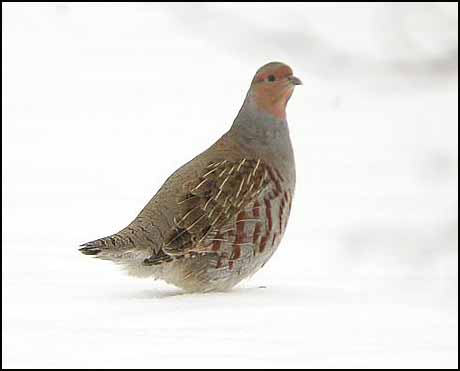Partridge - Gray
Hungarian Partridge, English Partridge, Hun, European Partridge, Bohemian Partridge Scientific Name: Perdix perdix
Sat, 5th October, 2024 - 7:24 am GMT
Sponsor Ads:

Alternative Name
Hungarian Partridge, English Partridge, Hun, European Partridge, Bohemian Partridge Scientific Name: Perdix perdixBasic Info
At maturity, Gray Partridges measure between 12 and 14 inches (30 to 35 centimeters) in length. They are round in shape with short tails. As their name would indicate, Gray Partridges are mainly gray, although their faces have rusty coloration and they have chestnut brown banding over their sides. The plumage is not uniformly colored; rather, it has many markings and variations of well-defined black, brown, or gray. The tails and lower backsides are reddish in color. Male Gray Partridges can be identified by the dark splotch on their bellies that forms a horseshoe shape. The crowns of Gray Partridges also demonstrate the sexual dimorphism of the species. In females, these areas are dark brown. Males have ash colored or light bluish crowns. Females' crowns are decorated with light tan teardrop shapes, while males have light, straw to buff colored pinstripes that become more pronounced near the napes of their necks.
Health
Gray Partridges eat seeds and grains in the wild, supplemented with green vegetation and insects. Their captive diets should reflect this. Young Gray Partridges have higher protein requirements than adults, as in the wild they feed primarily on insects. Breeding Gray Partridges usually build their nests as shallow scrapes located in areas of dense undergrowth or other cover. The nests may be lined with grasses. Females bob their heads at courting males, who puff up their chests and feathers and move their tails rapidly in up and down motions. Clutches may range from less than ten eggs all the way up into numbers greater than 20! The average clutch, however, contains between 12 and 18 eggs that will begin to be incubated after the last egg is deposited. Often clutches laid later in the year have fewer eggs than those laid earlier. After 21 to 26 days, the eggs hatch. Young Gray Partridges are usually full grown by the time they are three or four months old, and can attempt flight as early as one to two weeks of age! Most Gray Partridges spend their first winter with their parents. Young Gray Partridges eat insects, mostly, and mortality rates are high. Usually, only eight birds of the entire clutch will survive to leave their parents in the spring of the year following their hatching.Habitat
Meadows and farmlands are common habitats, although in winter weather, Gray Partridges may leave more open spaces for more sheltered areas, like the edges of woods.Behavior
The lovely, round Gray Partridge may be inspiration for the common holiday song, "The Twelve Days of Christmas", whose refrain speaks of a "partridge in a pear tree"! These beautiful birds, not native to North America, were introduced there from Eurasia, and continue to flourish on both of these continents today. Usually, Gray Partridges live in groups known as coveys. In the spring, they tend to be more solitary in behavior, however, and can often be found in pairs or individually. They prefer areas of tall grass, in which they can forage for food largely undetected. In snowy weather, they can actually burrow into the snow in order to access forage beneath it. They eat seeds, leaves, and insects, although in agricultural areas where waste grain material is available, they may incorporate this into their diets as well. Although Gray Partridges usually do not migrate, some populations living in harsh climates, especially those in eastern Europe, may sometimes move south for the winter. Males attract females with a harsh, creaking call.Origin
North America, Asia and EuropeHistory
The Gray Partridge, native to many areas of Europe and west to central Asia, was introduced to North America around 1790 because they were highly valued as game birds. They are often called Hungarian Partridges, or Huns for short. Although they existed in North America, they did not have significant population numbers until the 1920s, when they began to be imported in large numbers.Common Foods
N/ASponsor Ads:
"To begin by bluster, but afterwards to take fright at the enemy's numbers, shows a supreme lack of intelligence." -- Sun Tzu, The Art of War
Partridge - Gray
Coded by: BGID® | ALL RIGHTS RESERVED Copyright © 2000-2024
Disclaimer | Privacy | Report Errors / Contact | Credits









